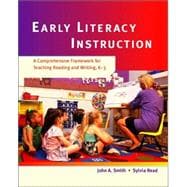
| Reading and Writing Instruction Frameworks | |
| What Is Reading? | |
| Foundations of Literacy | |
| Reading Aloud | |
| Word Study | |
| Independent Reading | |
| Guiding and Supporting Students' Reading | |
| Writing Instruction | |
| Nonfiction Reading and Writing | |
| Reading Assessment | |
| Interventions for Struggling Readers | |
| Putting It All Together | |
| Word Parts We Use | |
| Spelling Pattern and Chunks List | |
| Final Silent E Flash Cards | |
| Vowel Team Flash Cards | |
| Spelling Pattern Bingo | |
| Spelling Test Page | |
| Story Maps | |
| Story Map Response Form | |
| International Reading Association Standards for Reading Professionals | |
| Glossary | |
| Table of Contents provided by Publisher. All Rights Reserved. |
The New copy of this book will include any supplemental materials advertised. Please check the title of the book to determine if it should include any access cards, study guides, lab manuals, CDs, etc.
The Used, Rental and eBook copies of this book are not guaranteed to include any supplemental materials. Typically, only the book itself is included. This is true even if the title states it includes any access cards, study guides, lab manuals, CDs, etc.